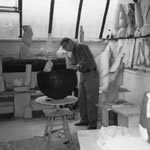
GORDON BALDWIN (b. 1932)
Gordon Baldwin studied painting and pottery, first at the Lincoln School of Art and then at the Central School of Art and Design in London. Strongly influenced by contemporary sculpture, Baldwin began handbuilding in the 1950's using a variety of techniques and has since gained a reputation as a major artist.
He has made work in both earthenware and stoneware, often reworking and refiring pieces several times. Primarily concerned with the vessel, his work has become increasingly sculptural in nature.
Gordon Baldwin is represented by Barrett Marsden Gallery,
London.
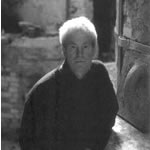
CLIVE BOWEN (b. 1943)
Clive Bowen initially trained as a painter at Cardiff College of Art before going to work with Michael Leach at the Yelland Pottery in Devon and becoming a potter himself. He produces slip-decorated earthenware pots, which he woodfires at his studio in Shebbear, Devon.
He says: "The form and function of my work can be traced back to centuries-old pots such as English mediaeval jugs and early Tamba ware. I hope that I am re-inventing them and not merely imitating them."
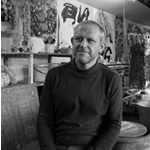
SIMON CARROLL (b. 1964)
Carroll
creates exuberant, challenging and expressive ceramic vessels which are
often richly painted or dripped with slips and glazes. The lively sculptural
forms are inspired by an eclectic range of sources including Henri Matisse
and Elizabethan ruffles. In 2005-6 he had an installation at the Tate
St Ives in Cornwall.
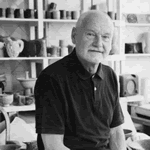
EMMANUEL COOPER (b. 1938)
Emmanuel Cooper works in stoneware and porcelain, making mostly bowls and jugs which are finished in a diverse range of glazes. He is editor of Ceramic Review and author of many books on ceramics. His work is included in a number of major collections, including the Victoria and Albert Museum. He is currently Visiting Professor, Ceramics and Glass, Royal College of Art and Guest Curator of Applied Art, Tate St Ives.
ANDREW CROUCH (b. 1955)
Andrew Crouch studied at the Bath Academy of Art before establishing his 'Marches Pottery' in Ludlow in 1982. He produces a range of tableware abd individual pieces in stoneware and porcelain. All his work is hand thrown.
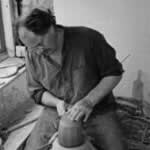
MIKE DODD (b. 1943)
Mike Dodd has been based in Somerset since 1994, after working at a number of studios since he set-up as a potter in 1968. He is keen to expand his conversation with clay, a dialogue rooted in his love of nature and its geological riches. He emphasizes how his creative outlook is based on feeling rather than noesis, and it is simply a deep affection for what he does that justifies his position as a dedicated functional potter, wanting to speak through the breath of the material.
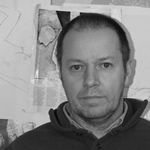
PHILIP EGLIN (b. 1959)
Born in 1959, Philip Eglin trained at Staffordshire Polytechnic and at the Royal College of Art. Inspiration for his recent work comes from Northern Gothic religious woodcarvings, Chinese export porcelain, English folk ceramics and the language of symbols used on contemporary packaging.
His work can be found in the collections of the Stedelijk Museum, Amsterdam; National Museums of Scotland, Edinburgh; Fitzwilliam Museum, Cambridge; and the Victoria & Albert Museum, London. He was the winner of the Jerwood Prize for Applied Arts: Ceramics in 1996.
Philip Eglin is represented by Barrett Marsden Gallery, London.
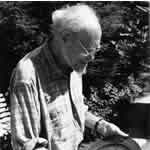
RAY FINCH (b. 1914)
Ray Finch was born in London and studied at the Central School of Arts and Crafts in London. He worked with Michael Cardew at the Winchcombe Pottery in Gloucestershire, and eventually took over the pottery in 1946 and continues to work from the studios. The pottery produces a wide range of domestic ware. Slipware gave way to stoneware in the 1960s, and the pieces were high fired in a large wood fired kiln. The emphasis of his work had always been, in both the standard range and individual pieces, to make pots which are both to be used and enjoyed.
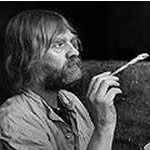
GEOFFREY FULLER (b. 1936)
Geoffrey Fuller tarined at West Surrey College of art and Design, Farnham, and went on to become a technician there before setting up his own studio. He now works in Buxton making both thrown slipware domestic pots and imaginative handbuilt slipware figures.
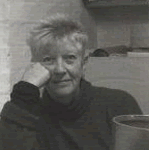
JANE HAMLYN (b. 1940)
Jane Hamlyn makes salt-glazed ceramics, sometimes functional, sometimes sculptural, such as her recent 'Empty Vessels' series. She trianed at Harrrow before setting up her own pottery in Yorkshire in 1975. Her work in represented in many public and private collections, including the Victoria and Albert Museum.
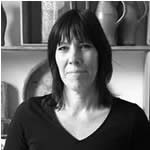
LISA HAMMOND (b. 1956)
Lisa Hammond produces a range of high temperature soda glazed studio pottery, both functional and decorative, and a range of individual ceramics, made in series and to commission. Lisa also makes a range of studio pots often using shino Glaze.
Lisa
has taught in many universities and colleges both in this country and
abroad and is a fellow of the Crafts Potters Association. Her work is
represented in museums and collections in both the UK and overseas.
BRYAN ILLSLEY (b. 1937)
Painter, sculptor and silversmith Bryan Illsley studied at Kingston Schhol of Art, London. He then worked as a packer at Leach Pottery then went to work in Breon O'Casey's studio, eventually becoming a partner. He lived in St Ives for a number of years, before moving back London in 1986, where he continues to live and work today.
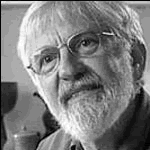
WALTER KEELER (b. 1942)
Walter Keeler studied at Harrow School of Art. He established his first studio in 1965 and in 1976 moved to Monmouthshire in Wales, where he continues to live and work today. Keeler is widely reknowned for his work with salt-glaze, producing inventive variations on domestic forms. Recently he has also been producing works inspired by 18th Century English Whieldon-ware made from earthenware and glazed with colour to give a tortoiseshell effect.
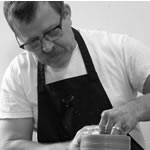
DAN KELLY (b. 1953)
Dan Kelly trained at the Camberwell School of Arts and the Royal College of Art, before setting up studios in London with the help of a New Craftsman grant from the Crafts Council in 1980. He has exhibited widely, and was included in Galerie Besson's "Camberwell in the 1970's" exhibition in 2005.

RODNEY LAWRENCE (b. 1950)
Rodney Lawrence studied pottery at the Harrow School of Art as was a student of David leach. He set up a studio with partner Elizabeth Raeburn in a converted Chapel in Somerset in 1976. He makes low-temperature stoneware, producing both wheel-thrown and hand-built forms with varying colours and textures; often sgrafitto-decorated.
He
has exhibited widely, and has pots in both private and museum collections
throughout England and abroad.
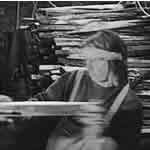
JIM MALONE (b. 1946)
Jim Malone studied ceramics at Camberwell during the early 1970's. Upon graduating he established his first pottery studio in North Wales, making pots and working as a visiting lecturer in Wales and at Camberwell. After a move to Cumbria in the 1980’s he returned to full time potting in 1990 and has held numerous exhibitions since then. In 1997/8 he was also honoured with a major retrospective exhibition organised by the Bolton Museum and Manchester Metropolitan University.
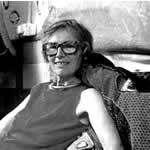
CAROL McNICOLL (b. 1943)
Carol McNicoll has an international reputation as a ceramicist. Her work explores the relationship between two and three dimensional figurative imagery, always within the context of functional ceramics. She has always been concerned with pattern, and uses glazes, open stock transfers and her own transfers to create richly patterned surfaces.
Born in Birmingham, Carol McNicoll studied Fine Art at Leeds Polytechnic and ceramics at the Royal College of Art, London. In 2001 she was short-listed for the Jerwood Prize for Ceramics and a major retrospective of her work toured the UK as part of the Craft Council‘s Show5 initiative in 2003-5.
Carol McNicoll is represented by Barrett Marsden Gallery, London.
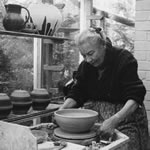
URSULA MOMMENS (b. 1908)
Unable to train as an apprentice potter, Ursula Mommens spent three years at the Central School and then worked under William Staite Murray at the Royal College of Art in 1930-32. She then set up on her own, converting an old cowhouse in Kent, using a flowerpot wheel and an oil kiln.
She went to work with Michael Cardew in Cornwall during the war and she cites him as her chief inspiration ever since. She set up her current pottery in Newhaven, Sussex in 1955 with Norman Mommens and continues to make both wood and gas fired functional stoneware with her own clay body and ash glazes.
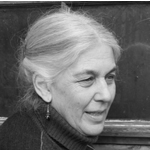
ELIZABETH RAEBURN (b. 1943)
Elizabeth Raeburn studied Studio Pottery at Harrow School of Art. While there, she spent a brief but influential time as a production student in David Leach's workshop. In 1975 she moved to Somerset, where she established a pottery with Rodney Lawrence. Since 1981, she has concentrated on Raku firing. Her work is represented on the British Craft Council Selected Index, and in many public and private collections at home and abroad. Her solo exhibitions include the Oxford Gallery, the Galerie für Keramik und Kalligraphie in Hamburg, the Dan Klein Gallery, and Galerie Besson in London. In 2003 she was one of four of David Leach's students whose work was included in his retrospective exhibition which toured the U.K. in 2003/4.
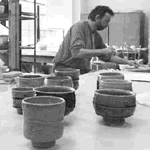
PHIL ROGERS (b. 1951)
Phil Rogers was born in South Wales and has been a potter for 29 years. He has had numerous exhibitions in the UK and overseas and his work is represented in over thirty public collections worldwide. He produces a two different bodies of work. The first is salt-fired and the second is glazed, as far as possible, using locally found materials particularly wood ash. His work is inspired by a wide range of ceramic traditions including medieval European pottery.
Phil Rogers has conducted many workshops both in Britain and abroad. He has also written two books on glazes and contributed to a number of ceramic journals.
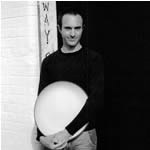
DANIEL SMITH (b. 1971)
Daniel Smith produces a wide range of hand-thrown porcelain tableware. His honest and simple approach results in an understated elegance. The weight of the porcelain in the hand combined with the pure delicate forms makes each piece a delight to hold and use.
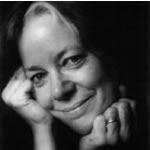
JOSIE WALTER (b. 1951)
Josie Walter first worked as a secondary school teacher before she began working with clay. She trained at Chesterfield College of Art, then opened a studio in Matlock with fellow student John Gibson. Desiring further experience in production throwing and running a business she then worked for Suzie and Nigel Atkins at the Poterie du Don in the Auvergne, France. She worked at Le Don as an apprentice for 6 months in 1980 making salt glazed domestic ware, and then returned to the workshop in Matlock where she made once fired decorated earthenware pottery. In 1996 Josie went back to college part time to study for an MA in History of Ceramics at Staffordshire University. She now works from a studio in her garden in Derbyshire.
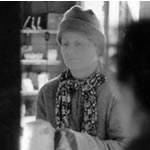
SARAH WALTON (b. 1945)
Sarah Walton studied Fine Art at Chelsea from 1960-64 and Studio Pottery at Harrow from 1971-73. She lives and works in Selmeston, near Lewes, in East Sussex where she has run a pottery since 1975 using a large oil-fired saltglaze kiln. She acknowledges a debt, amongst other sources of inspiration, to mediaeval pots, the arts of Mesopotamia and South-East Asia and Neolithic Art.
As well as domestic ware, Sarah has been making a range of stoneware birdbaths since 1984. Her ceramics are represented in numerous museums, including the Victoria and Albert Museum. She has also been the recipient of five awards, including a setting up grant from the crafts council in 1975.
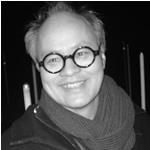
TAKESHI YASUDA (b. 1943)
Takeshi Yasuda was born in Tokyo and trained at the Daisei-Gama Pottery in Mashiko from 1963 to 1966. He then worked at Mashiko for a further seven years before settling in Britain in 1973. He is well known for his unique tableware and his critical survey of contemporary European eating habits. He is a studious observer of European dining rituals and passionate about food and cooking. His work is represented in numerous prestigious collections, including that of the Crafts Council and of the Victoria and Albert Museum. He has held one-man exhibitions in Britain and in continental Europe as well as in Australia and Japan. He is currently teaching ceramics in China.